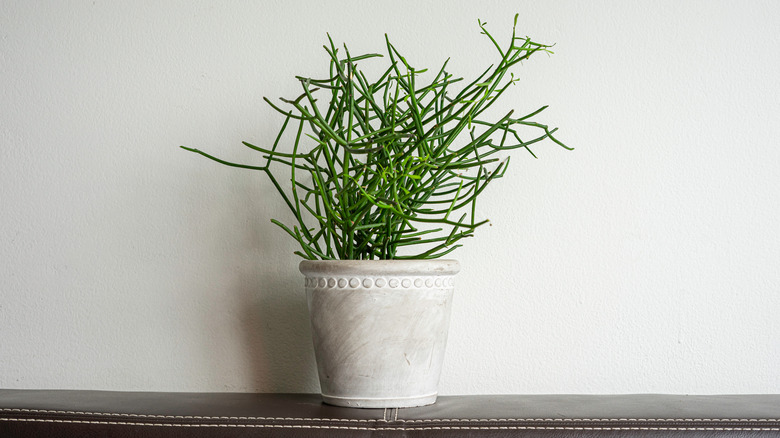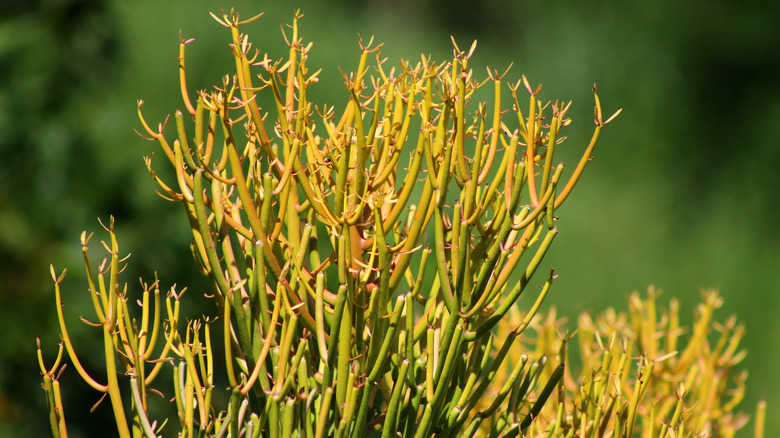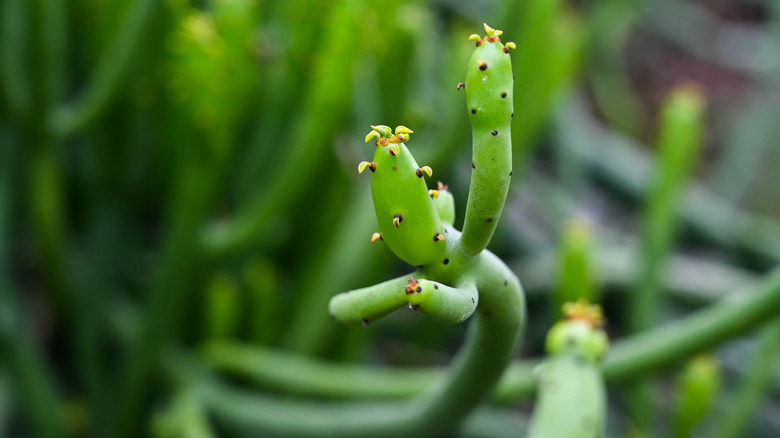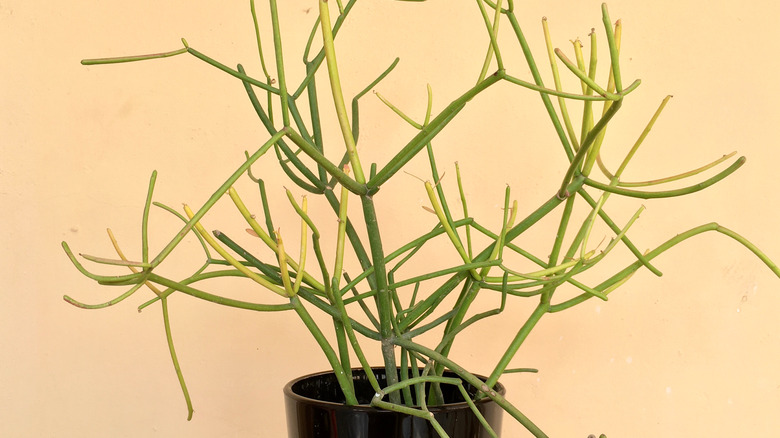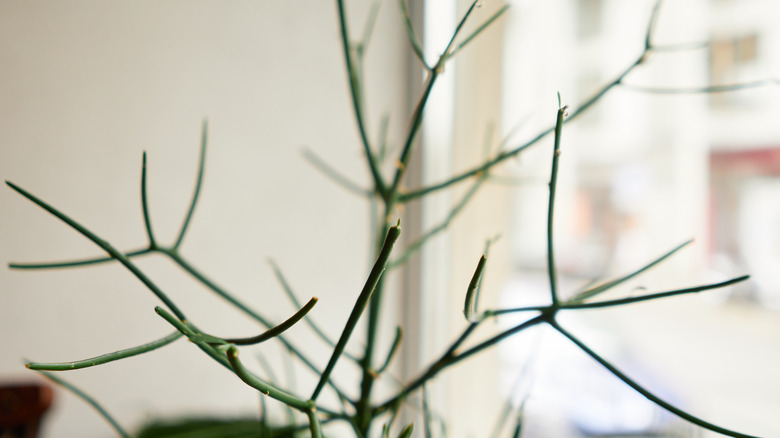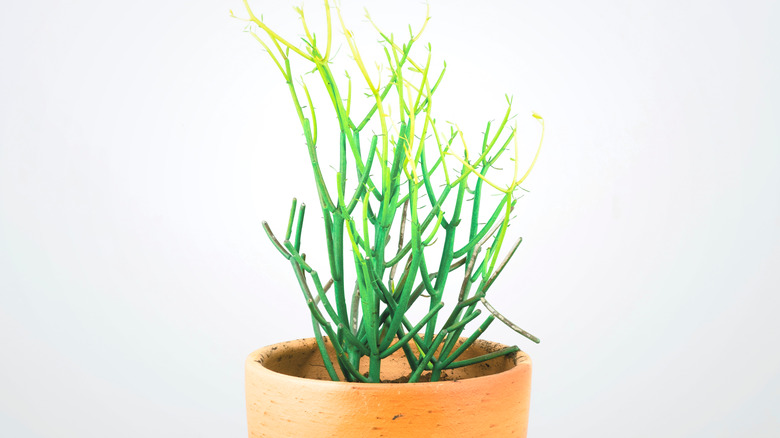How To Care For A Pencil Cactus
Euphorbia tirucalli, also known as the pencil cactus, Indian tree spurge, and pencil tree, is native to the tropical semi-arid climates of Africa and Western Asia, according to The Spruce. However, today, you can find this plant growing in people's homes worldwide because it is an easy houseplant to keep alive and a wacky addition to any plant collection.
The pencil cactus gets its common name from its thin branches, which are about the same thickness as a pencil. These fleshy stems grow on top of one another, helping the tree reach up to 4 feet tall and 6 feet wide when grown indoors. Outdoors, the pencil tree can reach up to 30 feet in height, as per The North Carolina Extension Gardener Plant Toolbox. In addition to its peculiar branches, this succulent plant can also feature small green leaves only growing about 1 inch wide and often falling off as they reach maturity. Small yellow flowers may also be visible at some stems' end, but they drop off once the growing season ends.
How to use a pencil cactus in the garden
As explained by GardenBeast, the pencil cactus can only grow outdoors in temperatures that won't drop below 50 degrees Fahrenheit. So if you want to grow this tree outside, you need to live in USDA hardiness zones 11 or 12 because they love full sun and won't need much care after they've been planted in well-draining soil.
The best way to bring a pencil cactus into your outdoor landscape is to plant it in an area with plenty of room to grow. It can become fairly large in a matter of years and quickly take over a garden. Some people growing a pencil cactus in the U.S. treat it as a tree, placing it in a large garden area with flowers that will complement its branches. As told by Gardenista, the cactus pairs great with Sedum Angelina and Firestorm as well as Crassula Campfire, all of which feature bright, warm color patterns.
How to grow a pencil cactus
The pencil cactus takes little effort to grow. All you need to get it thriving is well-draining soil supplemented with sand and a pot with an adequate drainage hole. The best way to grow your own pencil cactus is to either buy a young plant from your local nursery or propagate one from cuttings.
To grow a pencil cactus from cuttings, you should first gather your protective gear. The sap inside the pencil cactus is toxic and known for causing skin irritations and other problems if ingested. Therefore, you should always wear gloves, eye protection, long sleeves, and long pants when dealing with this plant, warns MasterClass. Once protected, cut off a 6-inch long stem for propagation and immediately dip its end into some water to arrest sap flow. Then, wrap the cutting loosely in a paper towel and keep it in a cool, dry place to let it callus. After a week has passed, it should be ready for potting. Place the stem in a succulent pot and cactus potting mix and wait for the roots to take hold.
How to care for a pencil cactus
Many plant parents agree the pencil cactus is a no-fuss kind of houseplant. As long as it has the right soil type and plenty of sunlight, this plant is as happy as it can be. When growing a pencil cactus indoors, place it in a window where it will get direct sunlight. The North Carolina Extension Gardener Plant Toolbox tells us that your pencil tree should get up to six hours of direct sun every day.
The watering schedule you'll need to adhere to for this succulent may seem a little confusing at first, but we're sure you'll get it. Water your pencil cactus every two weeks in the summer and spring, aka the growing season. In the fall, reduce watering to only once per month. Finally, in the winter, don't water it at all, as suggested by The Spruce. The pencil cactus is extremely drought-tolerant; too little water is certainly better than too much. Make sure that the soil is mostly drying out between each watering to avoid drowning your cactus, which can lead to an array of problems.
Is the pencil cactus toxic?
The pencil cactus can be extremely dangerous. As we already mentioned, the sap inside its branches is a powerful irritant known for causing rashes and irritation on the skin that it comes in contact with. As with any allergen, it will affect some people more than others. But, it's best to play it safe and avoid the sap no matter what. As warned by The University of Arkansas, it is not uncommon for people to be sent into anaphylactic shock after dealing with this plant without protection. In some cases of an allergic reaction it has caused burning, numbness, and even temporary blindness.
According to the ASPCA, the sap is toxic to cats, dogs, and horses. Ingesting the sap of a pencil cactus can lead to mouth and stomach irritation as well as vomiting in severe instances. If you keep this succulent as a houseplant, be sure it is out of reach from children and pets.
How to repot a pencil cactus
As per GardenBeast, your pencil cactus only needs repotting every two or three years. However, you should check its drainage hole regularly for roots coming out, which would indicate that it needs repotting sooner. For best results, transplant your pencil cactus during the spring when its soil is completely dry. Before repotting, make sure you have gritty, well-draining potting soil and an unglazed clay pot on hand. This pot should be only 1 or 2 inches larger than your cactus' rootball.
When you have all your supplies ready, including your PPE, start the repotting process by carefully removing your pencil cactus from its container. You may use a flat tool to dislodge the soil from the edge of the pot if you are struggling with this step. Once the plant is out of its pot, break up the dirt sitting in the roots to expose the rootball further. When much of the excess dirt has been removed, place your pencil cactus in its new container with fresh soil. Pack the potting mix on top of the roots and around the base of the plant to secure it. Often, these succulents are quite top-heavy. The Spruce suggests decorating with small rocks above the soil to support the plant even more.
